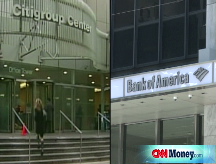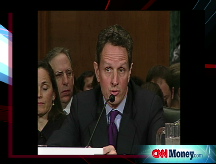Treasury prices continue to slide
Investors weigh recession concerns and a record supply of debt headed to market. The 30-year bond slides more than shorter maturities on long term inflation concerns.
NEW YORK (CNNMoney.com) -- Government debt prices were mostly lower Thursday as investors balanced concerns over the recession against a record supply of debt headed to market to fund stimulus programs.
The Treasury market has been very volatile, as has the rest of the financial marketplace. Wall Street sunk Tuesday - Inauguration Day - snapped back Wednesday, with the Dow Jones industrial average surging 279 points, only to fall sharply again Thursday.
Treasury prices have been trending lower in recent sessions despite dour economic news and a crumbling banking sector. Typically, demand for Treasurys surges in times of economic uncertainty and slow growth. But in this environment, investors know that more bad economic news means more stimulus spending, which means more government debt in the pipelines.
Supply headed to market: Wall Street nearly imploded in the wake of Lehman Brothers' unexpected collapse, and the resulting market tumult pushed bond prices to record highs and yields to record lows by the end of 2008. Investors had insatiable demand for the safety of government bonds. Yields on shorter-term notes were hovering at and even below zero.
The government embarked on an unprecedented rescue for the economy, including stimulus packages and capital injections into the financial system that have the government predicting the deficit will top $1 trillion in fiscal 2009. President Obama is intent on pushing another stimulus package through Congress in his first days in office.
In order to fund the rescue packages for the economy, the government will have to issue a record amount of debt. Treasury prices had been falling sharply as the market anticipates this onslaught of debt. This week alone, the Treasury auctioned almost $120 billion worth of debt.
Demand slackens: The 30-year bond has fallen more than other shorter term maturities, as investors grow cautious about inflation. "Most in the marketplace believe that in some juncture in the economy, there will be some inflationary pressures," said Ken Naehu, managing director and head of fixed income at Bel Air Investment Advisors.
The U.S. central bank currently has the key interest rate set with a target range of 0% to 0.25%. While Naehu was not suggesting that the economy was on the verge of a quick recovery, he explained that "the 30-year bond has to think well ahead."
In addition to the long-term potential for inflation, Naehu said foreign demand for Treasurys could decline as other countries choose to invest their cash in their own domestic infrastructure projects.
Also contributing to the decline in Treasury prices is the increasing interest in other bond markets. "Low rates have encouraged investors to find alternatives that offer higher return," Naehu said, citing higher grade corporate bonds and municipal bonds. Corporate bonds and municipal bonds offer safety from the stock market as well as the potential for higher returns than what Uncle Sam's debt offers.
Debt prices: The 10-year benchmark Treasury note fell 19/32 to 109-28/32, and its yield rose to 2.61%. Bond prices and yields move in opposite directions.
The 30-year bond sunk 2-8/32 lower to 123-10/32, and its yield was 3.26%. One week ago, the 30-year bond was trading above 132 and its yield was at 2.87% in mid-day trade.
The 2-year note rose less than 1/32 to 100-7/32, and its yield was 0.78%.
Meanwhile, the yield on the 3-month note was 0.12%, unchanged from Wednesday. The 3-month bill has been used as a gauge of confidence in the marketplace because investors tend to shuffle funds in and out of the bill as they asses risk in other places.
Lending rates: Lending rates rose Thursday. The 3-month Libor rate increased to 1.16% from 1.12% Wednesday, according to data available from Bloomberg.com. The overnight Libor rose to 0.21% from 0.19% Wednesday.
Libor, the London Interbank Offered Rate, is a daily average of rates 16 different banks charge each other to lend money in London, and it is used to calculate adjustable-rate mortgages. More than $350 billion in assets are tied to Libor.
Two credit market gauges showed signs of less confidence in the credit markets.
The so-called "TED" spread, a measure of banks' willingness to lend, widened to 1.04 percentage points from 1.02 percentage points Wednesday. The bigger the TED spread, the less willing investors are to take risks. The rate surged as the credit crisis gripped the economy, but has since fallen off as central banks around the world have lowered interest rates and pumped the economy with liquidity.
Another market indicator, the Libor-OIS spread, widened to 0.93 percentage point from 0.92 percentage point Wednesday. The Libor-OIS spread measures how much cash is available for lending between banks, and is used for determining lending rates. The bigger the spread, the less cash is available for lending.
Commercial paper: A combination of government programs have helped to open up the credit markets, which became log jammed in the fall.
One government program, the Federal Reserve's Commercial Paper Funding Facility, which started in late October, allows companies to sell highly rated 3-month debt to the government in exchange for ultra-low interest rates.
Commercial paper is short-term debt that big businesses and financial institutions issue to pay for day-to-day business operations such as payroll and utilities. The debt was traditionally purchased by institutional investors as a safe and secure asset, but since Lehman Brothers' demise, investors have been more hesitant to purchase the paper, leaving some companies unable to get the cash they need to meet their daily obligations.
A Fed report released Thursday showed that business lending contracted for the second week in a row. The amount of so-called commercial paper that was sold in the seven days ended Jan. 21 fell by $30.1 billion, or 1.8%, to a seasonally adjusted $1.69 trillion. ![]()





